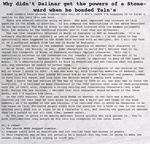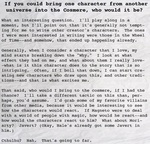Cyrus the Not Too Bad
You are known for being extremely meticulous in planning out the structure and details of your stories before writing. That being said, are there any times you have come up with a new idea or plot point as you are writing and just went with it?
Brandon Sanderson
Yeah, it happens all the time. I am, as I've come to learn, relatively detailed in my outlines compared to a lot of my contemporaries. (I am not the most detailed; I think that prize probably goes to Kevin J. Anderson. His outlines tend to be just basically the book, but shorter.) If you've seen me talk about my outlines, there are a lot of bullet points in there and goals; I don't know exactly what's gonna happen in each chapter, I'll know what I want to achieve in each chapter, which is a little bit different. I'll know, "these two characters need to interact, this information needs to come out, and this event happens to end the chapter." I'll know things like that. However, as I'm writing, as you're putting the book together, as you're getting in the zone and really getting to understand how the book is feeling and flowing, you start to change things, just from the first chapter. Not even it comes out exactly like planned most of the time. And this is just a part of the process.
Now, I am an outliner, which means that when one of these things happens, I will often go with it, but I'll also be revising my outline. I'll take a little bit of time to just go with it and see how it goes, often. But a lot of times, I'm already working on my outline. I'm already saying "oh, this is a much better idea, this is working way better." Trying to remember... from a first book, a time where that happened. Famously, Adolin wasn't a viewpoint character in the original draft of The Way of Kings, but that didn't happen during the drafting, that was during the revision process, so it's not quite what you're asking.
The personality that Doomslug ended up having in Skyward was not something I had planned out. I just kind of went with it as it came along as I was writing. A lot of the personalities of the side characters in Skyward are a good example of this. Like, even Jorgen's personality is quite different from what I had imagined in the outline. This happens a lot with characters for me that I'm writing, and who they are becoming is a much different person than who I maybe imagined them. Until I write through their eyes, I'm not 100% sure who they are. And this is the big thing that throws my outlines off. I know that my characters are going to grow to become different people than I imagined when I started, and the outline just has to adapt to that.
Unless it goes too far. Some of my fans who were watching back in the time, I added a character to Warbreaker just kind of on-the-fly as I was working on the beginning. And I really liked this character, they were great. So I'm like, "Wow, I want to bring this character on the adventure." And I wrote them into a couple of chapters, because they were just fun to write, and it just ruined the other chapters. The chapters no longer worked in the structure I was making, and it was a worse structure, and this character being along was taking away from the sense of isolation, which was a major theme for Siri in that book. And I was posting these chapters online as I wrote them for Warbreaker. I just eventually said, "This character is no longer coming on the adventure" and pretended they hadn't been there in the next chapter I posted. That happens sometimes, too, where you just decide to edit something down.


